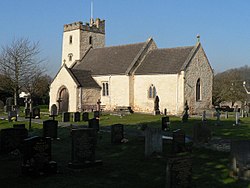Portskewett
Portskewett
|
|
|---|---|
 Parish church of St. Mary |
|
| Portskewett shown within Monmouthshire | |
| Population | 2,133 (2011) |
| OS grid reference | ST499881 |
| Principal area | |
| Ceremonial county | |
| Country | Wales |
| Sovereign state | United Kingdom |
| Post town | CALDICOT |
| Postcode district | NP26 |
| Dialling code | 01291 |
| Police | Gwent |
| Fire | South Wales |
| Ambulance | Welsh |
| EU Parliament | Wales |
| UK Parliament | |
Portskewett (Welsh: Porthsgiwed or Porthysgewin) is a community (parish) and village in Monmouthshire, south east Wales. It is located four miles south west of Chepstow and one mile east of Caldicot, in an archaeologically sensitive part of the Caldicot Levels on the Welsh shore of the Severn Estuary. The Second Severn Crossing passes overhead carrying the M4 motorway.
At the eastern edge of the village, in a privately owned field opposite Black Rock Road, very near to the Leechpool turn, is evidence of a significant neolithic chambered tomb or long barrow.
A small group of puddingstones mark the entrance of the site known as Heston Brake. Human skeletons, cattle bones and some pottery were discovered in the chamber when it was excavated in 1888.
The stones can be reached by following the public footpath accessed via the kissing gate which is situated on the left about 150 metres (160 yd) from the main road toward Leechpool.
In his 1954 Monmouthshire Sketch Book Hando writes: "Garn Llwyd, Gwern-y-Cleppa and Heston Brake are our three outstanding dolmens".
There is some evidence of a Roman villa, with possible British Iron Age antecedents. There are also remains of a late Roman temple on Portskewett Hill, and many coins of the 3rd and 4th centuries have been found.
The name Portskewett is generally believed to derive from the Welsh Porth-is-Coed, meaning "the harbour below the wood", or alternatively "the harbour of the area below the wood" - that is, the post-Roman cantref of Gwent Is Coed, centred on Caerwent about 3 miles away. An alternative derivation is from Porth Ysgewydd, the port of the elder wood.
...
Wikipedia

